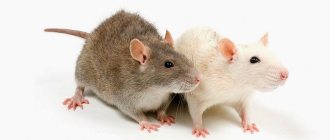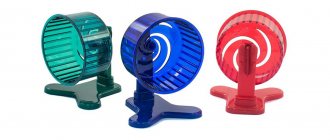Children love animals and often ask their parents to buy a four-legged pet with whom they can be friends and have fun. But purchasing a large dog or a fluffy cat is not always possible for various reasons. To please your child, you should pay attention to hamsters. From the age of seven, children can already be trusted to take care of a small animal. Caring for an animal instills kindness and responsibility in a child. But you need to take the choice of a rodent seriously. It is important to consider what breed and color the pet should be, preferably a girl or a boy. How to choose a hamster so as not to be disappointed in the purchase?
What things do you need to buy for your pet?
Before buying a little friend for your child, you should think about whether the family has time to take good care of the pet. A hamster is the same living creature as a dog and a cat. A tiny animal also needs attention, love, care, and normal living conditions. Therefore, it is not recommended to purchase an animal for children of kindergarten age who are not yet able to understand the importance and value of any life. A rodent cannot live without its own house, furnished with the necessary things and toys. For a hamster you definitely need to buy:
- spacious cage;
- sawdust for bedding;
- house for sleeping and relaxing;
- drinking bowl;
- a bowl for food;
- wooden toys;
- running wheel;
- tunnels;
- cell disinfectant;
- feed;
- mineral stone;
- vitamins;
- sticks for grinding teeth;
- various delicacies.
Ideal home
The animal is very mobile, so they need a lot of space. When choosing a cage, first of all, be guided by its size. The minimum cage size for one animal is 50*50*70 (length*width*height). It is optimal to choose a more spacious home - 60*50*100.
The higher the cage, the better! Chinchillas love to jump and climb on bars. The cage must have at least 2 shelves.
You can also equip a storefront, since such a house has several advantages. It has closed walls, so dirt will not fly out. In addition, the showcase looks more stylish and can be successfully integrated into the interior.
Unfortunately, display cases are not sold in pet stores. You can order them from craftsmen or make them yourself. You can use wooden shelves or an old chest of drawers as a basis.
Accessories
Chinchillas definitely need:
- feeder;
- drinking bowl;
- house;
- stone for teeth point;
- manhole;
- stones and branches.
When your home is ready, start arranging it. First, she needs a water bowl and feeder. It is better to choose hanging options, so the animal will always have clean food and water. It is advisable to purchase metal utensils, as the wood will quickly wear down.
Be sure to put a house in the cage. It would be better if it were made of wood. Of course, sooner or later it will be eaten, but the animals will get great pleasure from such a shelter.
You can distract the animal from the point of its teeth on the cage or house using a special chalk stone. A teeth pointing stone can be purchased at any pet store and hung on the bars of the cage.
Large stones and branches of permitted trees can be placed in the cage (see section Feeding). The chinchilla will be pleased with the system of manholes and pipes where it can hide. If the size of the cage allows, hang a hammock in it. You can buy a hammock for ferrets or sew one yourself from thick fabric.
Toys
To prevent your fidget from getting bored, place several toys in the cage. Don't be discouraged if your upgrades don't make much of an impact. Chinchillas are completely unpredictable. They may be happy with an ordinary branch and not react at all to a new hole or house.
The best toys for chinchillas are wooden blocks and walnut shells. Watch how enthusiastically she drags them around the cage and gnaws them.
Standard running wheels for hamsters and guinea pigs have too large distances between the bars. While running fast, an animal can easily damage its paw. There are solid wheels made of wood, they are difficult to find, but they will suit the shushi well. If you are afraid that your pet is not getting enough activity, equip the cage with pipes and hang a few extra shelves.
Where is the best place to buy a hamster?
Buying a pet is a responsible matter; you need to choose an animal at specialized sales points. Bird markets exist in almost every major population center, but it is not advisable to purchase a hamster there. Firstly, market traders keep live goods in disgusting conditions, do not monitor the health and well-being of animals, and feed them cheap and low-quality food. As a result, almost all rodents sold in markets have a cold, are infected with parasites or an infection. Secondly, if the purchased animal turns out to be sick and quickly dies, then it is impossible to return the money. Thirdly, market sellers, in order to sell goods to gullible buyers, often lie about the age, gender, breed and health status of the animals.
A pet store is a more acceptable option, but this place of sale also has pros and cons. Hamsters in the store are always healthy, kept in acceptable conditions, and fed normally. But store prices for live goods are significantly higher than market prices, and the selection of animals is not striking in variety. Sellers are sometimes disingenuous and try to sell old hamsters, passing them off as young animals. It is better to buy rodents from breeders. Kennel owners sell their animals at a high price, but there is no doubt about the health and thoroughbred quality of their pets. And the breeders’ rodents are also accustomed to being handled.
№9
They have very poor eyesight. They suffer from myopia and, like many animals, see everything only in black and white. However, poor eyesight was replaced by an excellent sense of smell. Hamsters easily distinguish each other by smell and also easily recognize their owner by smell.
They are also sensitive to sounds. They can hear in the ultrasonic range.
In addition, they have sensory nerves at the ends of their antennae, which help them sense their surroundings and more easily navigate in the dark.
Which hamster should you choose – male or female?
Since small rodents cannot be sterilized, the behavior of males and females is significantly influenced by hormones. It is difficult to say which hamster is better - male or female. If the owners plan to keep the rodent alone in a cage without mating, then it makes no difference who to buy. Boys are large, friendly, calm, and more tolerant of human hands. But they constantly mark their habitat with urine, so their fur smells unpleasant, and the cage needs to be cleaned often to eliminate the disgusting smell. The girls are playful, nimble and active. But if you buy a female in a pet store or market that was kept in the same cage with other hamsters, you can get unplanned offspring along with the pet.
Water treatments and nail trimming
Hamsters do not like to bathe, so water procedures should be used only when necessary. For bathing, a special shampoo for rodents is best, after which the fur should be blotted with a soft towel. If the room is cool and you are worried that it will freeze, you can lightly dry it with a hairdryer using a gentle stream of warm air.
Overgrown claws are cut off with great care using a special nail clipper or nail clippers.
flickr/pyza
What breed of hamsters is best to give to children?
Different breeds of hamsters differ not only in body length and coat color, but also in character. In order for a child to find a truly good and affectionate friend, parents should choose an animal not only with a cute appearance, but also with a cheerful and sociable disposition. What kind of hamster is best to get for keeping in a children's room? The most popular are Syrian and Djungarian rodents.
Syrian hamsters
Large, kind and flexible animals, not afraid of human hands. The optimal choice for children. Rodents of this breed do not show aggression, quickly get used to their owner, and can be taught to respond to a nickname. They are clean, love to wash themselves and tidy up their cage, and live a long time compared to dwarf hamsters, up to four years. The coat color of Syrians can be very different: golden, white, yellow, brown, gray, black.
Djungarian hamsters
If you choose who is better - a Syrian or a Djungarian hamster, then the Syrian will have the advantage. Djungarians are calm and affectionate dwarf rodents. They are bought for children if the dimensions of the home do not allow them to keep a large cage for a large animal of the Syrian breed. Djungarian hamsters are timid, and when they sense danger, they can jump out of your hands and seriously injure themselves, so they need to be handled carefully. Also, when a tiny pet escapes from its cage and hides under furniture, it is not easy to find it. So, parents who are thinking about which hamster to choose have no doubt that Djungarians and Syrians are the best option for their child.
Cell selection
A cage with vertical or horizontal bars is the most suitable and comfortable home for a hamster. Its size depends on the breed of hamster. For dwarf hamsters - Djungarian and Roborovsky - the height and width are approximately 30 cm, length - 50 cm. For golden or Syrian hamsters, it is better to choose a larger cage - 40 cm wide and high, about 60 cm long.
Unlike Syrian hamsters, Djungarian and Roborovian hamsters are indifferent to climbing rods and other acrobatic tricks, so plastic cages (dunes) are quite suitable for them. Under no circumstances should hamsters be placed in tall and narrow aquariums - bacteria multiply very quickly here, there is high humidity and there is almost no access to fresh air.
flickr/pyza
How to choose a healthy pet?
Purchasing an animal is a responsible event. It is better not to listen to sellers; their goal is to sell the goods in any way. It is not difficult to distinguish a healthy animal from a sick one, you just need to be attentive. First, you should definitely look into the cage: it must be clean, there must be fresh and high-quality food in the feeder, and the bedding must smell normal. It is important that males and females are kept in separate cages. Otherwise, you can buy a pregnant girl and get unplanned offspring.
You should buy a rodent with thick and beautiful hair, clean and shiny eyes. The animal should not have bald spots, tumors, discharge from the eyes, nose, mouth, ears, or anus. You should not take an animal with a butt smeared with feces and excessive salivation - it has diarrhea and a serious disruption of the digestive system. If a rodent has numerous scratches on its body and ears, then it is pugnacious. This pet should not be purchased for a child.
Getting used to the new home
In order for your new guest to quickly get used to his new conditions, give him a few days to leisurely explore his home. Once the initial stress has passed, innate curiosity will take over and the hamster will begin to explore its cage with interest, feeling increasingly confident.
If there is a need to take the animal, for example, to the veterinarian, it is not at all necessary to take the entire cage with you - it is enough to purchase a small carrier for rodents. Subsequently, it will come in handy during general cleaning of the cage. Alternatively, a well-ventilated cardboard box can be used.
flickr/pyza
How to choose an affectionate and kind hamster for a child?
When choosing a rodent, it is important to pay attention to its behavior. Since hamsters are nocturnal animals, it is better to observe them in the evening. An animal with a normal character and a healthy psyche behaves actively, runs through tunnels, spins in a wheel, digs in the litter. A sick and aggressive rodent is lethargic, apathetic, often freezes warily, and even falls into a stupor. To check the character of the animal, you can pick it up. If an animal squeaks heart-rendingly, bites, scratches, or tries to escape, then it is too wild and cannot be tamed.
Economic importance
Hamsters, like most rodents, harm grains, vegetables, and feed crops.
They trample and eat most of the plants around their burrow.
Wild species are carriers of pathogens: tularemia and tick-borne fever.
Pets can infect humans with skin fungus, and in rare cases, tuberculosis.
In southern countries, hamster skins are harvested.
How to determine the age of a pet?
How to choose a hamster for a child so that the gift does not die of old age before it is brought to the new owner? Sellers often lie about the age of live goods in order to get rid of them faster. It is recommended to buy two-month-old animals; they are already adapted to independent living. If you take a baby under three weeks old, it will die. Nursery owners calculate exactly when offspring are born, and pet stores should weigh rodents to find out how old they are. An adult six-month-old Syrian weighs 200 grams, and a Djungarian weighs 50 grams.
Housing problem
The first thing that needs to be prepared for a new settler is his home. A hamster's home should be free, spacious, clean and cheerful. Your pet needs a lot of space to play and run around, as well as a lot of exercise equipment, such as wheels and toys for self-entertainment.
For the convenience of the animal, the cage floor should be covered with sawdust and soft straw, so that the little tomboy can feel at ease and comfortable, because they love to pick at something.
During the day, babies prefer to rest from a busy night, which is why their cage should have space for a sleeping place. Most likely it will be some kind of box, or a whole house, since their range in pet stores is quite wide, into which light will not pass.
Hamsters are heat-loving creatures. They inherited this from their wild relatives, whose habitat is the hot, dry desert. Therefore, when looking for a place to install the cage, bet on a warm, secluded corner near the radiator and away from drafts.
However, it is not recommended to place small rodents in your or your child’s bedroom, since these babies tend to be active at night, which will disturb your sweet sleep.











